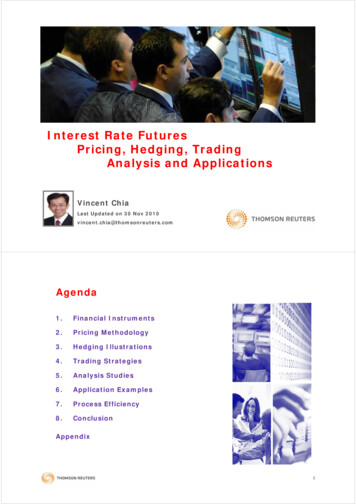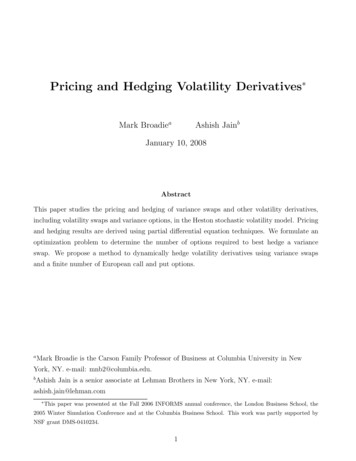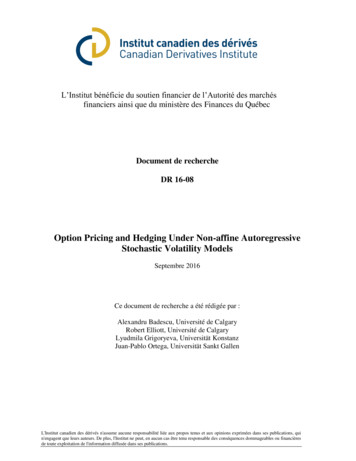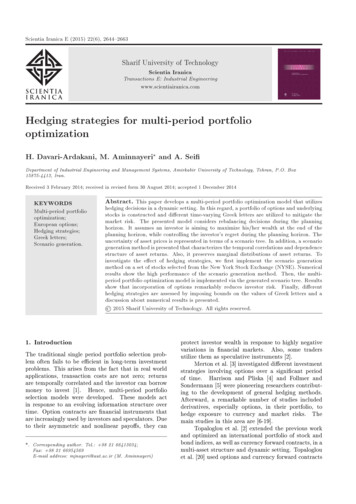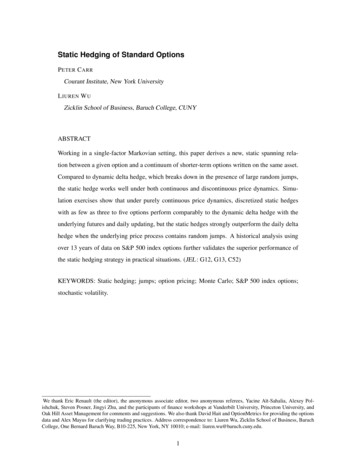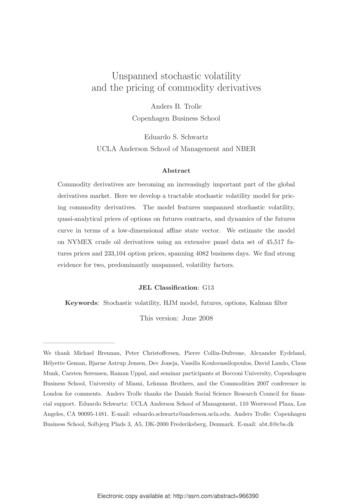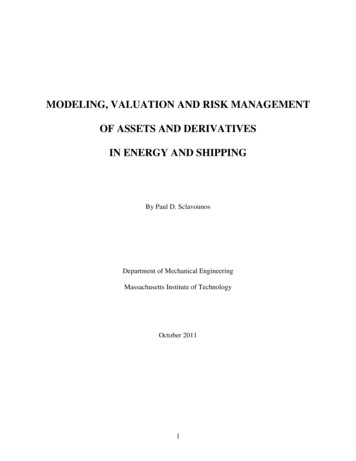
Transcription
MODELING, VALUATION AND RISK MANAGEMENTOF ASSETS AND DERIVATIVESIN ENERGY AND SHIPPINGBy Paul D. SclavounosDepartment of Mechanical EngineeringMassachusetts Institute of TechnologyOctober 20111
ABSTRACT:Derivatives are financial contingent claims designed for the pricing, transfer andmanagement of risk embedded in underlying securities in the fixed income, equity and foreign exchangemarkets. Their rapid growth spurred their introduction to the energy commodity and shipping marketswhere the underlying assets are real commodities, crude oil, refined products, natural gas, electricity andshipping tonnage. Risk neutral pricing and stochastic models developed for financial derivatives havebeen extended to energy derivatives for the modeling of correlated commodity and shipping forwardcurves and for the pricing of their contingent claims. This has enabled the valuation and risk managementof a wide range of assets and derivatives in the energy and shipping markets. They include storage fornatural gas, floating storage of crude oil, products and Liquefied Natural Gas in tankers, refineries, powerplants and utility scale wind farms, shipping structured securities, cargo vessels and shipping derivativesportfolios.KEY WORDS: Derivatives, risk neutral valuation, risk management, forward curves, futures,options, energy commodities, shipping, Forward Freight Agreements, freight options, PrincipalComponents Analysis, Canonical Correlation Analysis, hedging, stochastic optimal control,natural gas storage, crude oil floating storage, structured securities, wind energy.Investments in energy and shipping assets are exposed to interest rate, commodity price andfreight rate risks. The management of these risks has led to the introduction and widespread useof derivatives which have experienced explosive growth over the past several decades. In the2
fixed income market interest rate futures and futures options emerged in the 1980’s in responseto the need to hedge interest rate swap risk. This led to the development of financial models forthe arbitrage free evolution of the term structure of interest rates and the pricing of a wide rangeof fixed income derivatives, laying the foundation for the development of analogous models forthe arbitrage free evolution of the forward curves of physical commodities including crude oil,its refined products, natural gas and recently shipping freight rates.Commodity futures settle physically against the price of a spot commodity that must be deliveredat the contract expiration or in cash against a spot commodity index. The latter is the case inshipping where Forward Freight Agreements (FFAs) and freight rate futures settle againstshipping indices composed of a basket of freight rates. The first generation of commodity futuresmodels was based on the development of stochastic models for the spot index and the use of theprinciples of risk neutral pricing for the valuation of derivatives written on the spot. Recentmodels are based on the insight that in the absence of arbitrage futures prices with daily creditsand debits into a margin account are martingales. This has enabled the modeling of the evolutionof futures prices of any tenor as lognormal diffusions with zero drift in a Gaussian setting. Theprimary unknown in this model of futures prices is the volatility term structure which may beestimated from market prices of liquid futures and futures options. The arbitrage free priceprocess for the spot commodity or underlying index follows from this martingale representationof the entire commodity forward curve in the limit of small tenors.The martingale representation of the commodity forward curve lends itself to parsimoniousmodeling using the powerful statistical techniques of principal components analysis in the case3
of a single futures curve and of canonical correlation analysis in the case of multiple correlatedforward curves. In both cases a small number of statistical factors may be derived which areshown to follow mean reverting log-Ornstein-Uhlenbeck diffusions. This financial modeling andstatistical inference framework of cross-correlated energy commodity and shipping forwardcurves allows the pricing of a wide range of vanilla, spread and exotic derivatives written onfutures contracts. Moreover the model of the forward curve in terms of a small number ofstatistical factors enables the explicit valuation and hedging of wide range of energy andshipping assets with cash flow exposures that may be replicated by the prices of traded futurescontracts.This chapter reviews the fundamental developments that led to the introduction of financial andcommodity derivatives their stochastic modeling and risk neutral pricing. Pricing in Gaussianand non-Gaussian settings is addressed and shown in most cases to lead to closed form resultseven when the underlying is represented by an advanced stochastic model. The martingalemodeling of forward curves and their estimation by a principal components analysis is discussedfor the crude oil market, its refined products, natural gas and the shipping market.The valuation of real assets and financial claims of energy and shipping entities is discussed. Theparsimonious form of the arbitrage free factor models of the pertinent forward curves enable thepricing of these assets and securities by risk neutral pricing. Their risk management is alsoaddressed drawing upon the explicit form of the underlying factor model and the techniques ofstochastic optimal control which have found widespread use for the management of portfolios offinancial securities.4
ENERGY COMMODITY PRICE MODELSThe past several decades have witnessed the emergence and rapid development of the fields offinancial engineering and derivatives. Grown out of Paul Samuelson’s foundational insights onthe relationship between informationally efficient markets and the random walk and hisintroduction of the lognormal diffusion model of security prices, a wide range of stochasticmodels of security prices and arbitrage free valuation methods were developed for the pricing ofderivatives written on financial securities, real assets and other variables [see Samuelson (1965)].The use of these models and pricing methods in the fixed income, equity, foreign exchange andcredit markets is growing as is the complexity of the mathematical, econometric and filteringmethods necessary for their implementation. More recently, these methods have been adapted tothe energy and shipping sectors in order to control the high volatility of energy prices and freightrates and spur new investment.Spot Price ModelsEnergy commodity prices are characterized by idiosyncrasies not encountered in the financialmarkets. The volatility of the price of oil, natural gas and especially electricity is a lot larger thanthat of currencies, interest rates and equities. Energy prices often exhibit mean reversion,seasonality, sharp and asymmetric spikes which require the development of advanced pricemodels and derivative valuation methods, extensions of the Black-Scholes-Merton stock optionpricing formula. Moreover, a complex interaction often exists between the attributes of the spotphysical commodity and its forward contracts and other derivatives, not present for financial5
securities and their derivatives which settle electronically and do not require the delivery of aphysical asset. This requires the use of the extended risk-neutral valuation method of derivativeswritten on real assets and other variables that are not tradable [Ross (1976)].Standard reduced form stochastic models for the spot price of crude oil and natural gas arediffusions which account for mean reversion, seasonality and depend on hidden economicfactors. They include a stochastic convenience yield – the implied dividend received by theowner of the commodity held in storage – and a long-term stochastic equilibrium price to whichthe spot price mean reverts. The two-factor spot price models of Gibson and Schwartz (1990),Schwartz (1997) and Smith and Schwartz (2000) model the spot price and its factors asdiffusions and permit the explicit valuation of futures and forward contracts and their optionswritten on the spot commodity using the extended risk-neutral valuation of derivatives written onreal assets [Hull (2003)]. More general spot price models that may include stochastic volatilityand jumps are discussed in Clewlow and Strickland (2000) and London (2007). In the study ofCortazar and Naranjo (2006) the entire oil futures curve and its volatility term structure areshown to be very well modeled by a four-factor spot price Gaussian model which was estimatedby Kalman filtering.Stochastic models for the evolution of the electricity prices must account for sharp andasymmetric spikes, strong mean reversion, jumps and a dependence on structural factorsaffecting the electricity market. Reduced form stochastic models of electricity prices are usuallyjump-diffusions and Levy processes. An example is the jump-diffusion model of Kou (2002)which permits the independent parametric adjustment of the tail thicknesses of its probability6
distribution and allows the explicit pricing of electricity derivatives. Other models are discussedin Eydeland and Wolyniec (2003), London (2007) and Bength, Bength and Koekebakker (2008).Analogous models apply to the modeling of the spot price process of shipping freight rates.Forward Curve ModelsCrude oil and natural gas have liquid futures contracts trading on the New York MercantileExchange (Nymex) and the Intercontinetal Exchange (ICE) with tenors of several years. A largemarket also exists of swaps, forward and options contracts written on energy commodities thattrade Over The Counter (OTC). The relation between the prices of forward and futures contractsis discussed by Cox, Ingersoll and Ross (1981). Arbitrage-free forward curve models for energycommodities have been developed by Miltersen and Schwartz (1998) which accept as input themarket prices of liquid futures and lead to the pricing of a number of other derivatives. Thearbitrage-free evolution of the spot price follows from futures contracts of small tenors.The modeling of the oil and natural gas futures curve is based on the Heath-Jarrow-Morton(HJM) framework developed for the arbitrage-free modeling of the term structure of interestrates. A principal task of the HJM framework is the parameterization of the volatility andcorrelation structure of the futures curve by a small number of independent factors using aPrincipal Components Analysis. This was carried out by Sclavounos and Ellefsen (2009) whereit was shown that three Principal Components capture most of the fluctuations of the forwardcurve. In the same paper the arbitrage free evolution of the spot price was derived as implied inequilibrium by the forward curve and was shown to be driven by three independent factors thatfollow mean reverting logarithmic Ornstein-Uhlenbeck (log-OU) processes with stochastic drifts.7
Calls, puts, swaps, caps and their options written on futures contracts may then be valuedexplicitly as in the interest rate markets for use in energy risk management applications. [Hull(2003), Musiela and Rutkowski (2008)].Energy DerivativesIn addition to the standard derivatives discussed above, more complex derivatives have beenintroduced in the energy markets reflecting the economics of energy assets. In particular, powerplants are exposed to the spot/futures price difference of two energy commodities, e.g. naturalgas/electricity, coal/electricity, refineries are exposed to the price differentials of two fuels –crude oil/gasoline, crude oil/jet fuel -- and oil and natural gas pipelines and electricitytransmission lines are exposed to the price differentials of the same spot commodity at twodifferent geographical locations.A partial list of exotic derivatives used for the valuation, hedging and risk management of energyassets include options on the spread between two futures contracts with different expirationswritten on the same commodity, options on the price difference of two futures contracts with thesame expiration written on two separate commodities, options to exchange two spot commoditiesor their futures, average-price and average-strike Asian options, Barrier options which areexercised when the commodity price crosses a threshold and American swing options for thedelivery of an uncertain amount of the commodity. A discussion of these and other exotic energyderivatives is presented in Clewlow and Strickland (2000), Eydeland and Wolyniec (2003) andGeman (2005).8
Exotic energy derivatives are complex to price and hedge for advanced commodity price models.Furthermore, spread derivatives depend not only on the volatility but also on the correlationbetween various spot/futures contracts which may be challenging to model and calibrate tomarket prices. Consequently, the development of accurate stochastic price models and pricingmethods for exotic derivatives and spread options may be particularly helpful for the valuationand hedging of energy assets. Accurate analytical approximations of spread options prices andtheir hedge ratios are derived by Li, Deng and Zhou (2008) for two assets that follow correlatedlog-OU diffusions. Extensions to multi-asset spread option pricing and hedging are presented inLi, Zhou and Deng (2010).Shipping DerivativesThe success and rapid growth of derivatives in the energy commodity markets has spurred theirintroduction in the shipping markets. Shipping derivatives – Forward Freight Agreements (FFAs)and Freight Futures – were introduced in 1985 and are widely used by the dry bulk and tankershipping markets as discussed by Alizadeh and Nomikos (2009). Freight rate swaps were alsorecently introduced in the containership markets. The growth of shipping derivatives is alsomotivated by the correlation of the supply and demand for shipping ton-miles with that of thebulk commodities transported by cargo vessels -- crude oil, refined products, iron ore and coal.An example is the recent introduction of Over The Counter iron ore swaps following theinitiation of quarterly pricing of that bulk commodity. Therefore the need arises for the robuststatistical modeling of the correlated forward curves of shipping and commodity markets and thepricing of shipping derivatives for use in risk management.9
VALUATION AND HEDGING OF DERIVATIVESThe pricing of derivatives written on a financial security, a spot commodity or another variable –the underlying -- may be carried out by using the fundamental principles of risk-neutralvaluation. When the underlying is a non-tradable – e.g. temperature – an associated market priceof risk process enters in the derivative price which must be estimated from the prices of tradedinstruments. Otherwise, the fundamental economic insight of risk-neural pricing and theassociated mathematical techniques apply over a wide range of assets and stochastic models usedfor the modeling of the underlying process.Vanilla Derivatives for Jump-DiffusionsA standard derivative pricing method for the wide class of jump-diffusion processes is based onthe derivation of a risk-neutral probability measure under which European derivative prices maybe expressed as conditional expectations of a payoff at a specified horizon [Duffie (2001), Hull(2003), Shreve (2004), Musiela and Rutkowski (2008)]. Derivative prices expressed asconditional expectations may be evaluated explicitly in the form of Fourier integrals of thecomplex characteristic function of the jump-diffusion by using the methods developed by Heston(1993), Carr and Madan (1998), Duffie, Pan and Singleton (2000) and Lewis (2005). The use ofthis derivative pricing method in practice for the modeling of the equity implied volatility surfaceand the calibration of a wide range of jump-diffusion models are discussed in Gatheral (2006).10
Derivative prices expressed in the form of Fourier integrals allow the explicit evaluation of thederivative sensitivities known as the Greeks, they permit the analytical derivation of thestochastic process followed by the derivative price itself by using the Ito-Doeblin formula andoften allow the explicit pricing of European derivatives with more general payoffs. Theevaluation of Fourier integrals may be carried out efficiently by complex contour integration,numerical integration or Fast Fourier Transform techniques.The valuation of American options for jump-diffusions and the optimal stopping problems thatarise when early exercise is permitted is discussed in Oksendal and Sulem (2005). When the useof analytical techniques is not possible for the evaluation of American options and thedetermination of the early exercise boundary, the approximate method of Longstaff andScwhartz (2001), the quasi-analytical method described in Albanese and Campolieti (2006) andMonte Carlo simulation methods described in Glasserman (2004) may be used.Exotic Derivatives for Jump-DiffusionsThe valuation of a number of exotic derivatives is considerably more complex than their vanillacounterparts because their price depends on the path of the underlying process. Typical examplesare Barrier and Asian options. Therefore, the price of exotic derivatives is more sensitive on thestructure of the underlying stochastic process than is the price of vanilla calls and puts.Consequently, the choice of the underlying process and the subsequent pricing and hedging ofexotic derivatives may be a task of considerable complexity, a topic discussed for equities byGatheral (2006).11
For the geometric Brownian motion with constant drift and volatility explicit prices of a numberof exotic derivatives are derived in Shreve (2004). When the underlying process follows a jumpdiffusion, the pricing of exotic derivatives by Fourier methods leads to Wiener-Hopf problems inthe complex plane the factorization of which is often possible analytically. This is the case forthe jump-diffusion model of Kou (2002) which leads to the explicit valuation of Barrier options.These analytical results are developed in Cont and Tankov (2004) where the class of Levystochastic processes is also studied.The extension of these Fourier methods to the valuation of options on spread contracts and othercomplex energy derivatives is discussed in London (2007). In the same reference the derivationof the characteristic functions of a number of jump diffusion models of energy prices ispresented along with the valuation of weather derivatives.Statistical Inference of Asset Price ModelsAsset price models usually contain a number of parameters that need to be estimated uponcalibration of the model against market prices. This may be carried out by using the econometrictechniques presented in Cambell, Lo and MacKinley (1997), Greene (2000), Singleton (2006)and Tsay (2011).Stochastic models of commodity prices often contain hidden factors -- stochastic trends,volatilities and the convenience yield -- which are usually modeled as diffusions. The estimationof the models may be carried out by casting the time series obtained upon discretization in statespace form and using the Kalman filtering methods presented by Durbin and Koopman (2001).12
The simultaneous inference of the model parameters and hidden factors may then be carried outby using dual Kalman filters and the Expectations Maximization algorithm presented in Haykin(2001). These statistical inference techniques may also be used for the estimation of nonlinearstructural form models of power prices and shipping freight rates which are known to depend onnonlinearities in the supply and demand schedules of the underlying markets.Model parameters are usually estimated using standard econometric methods for examplemaximum likelihood estimation. However in practice parameters are uncertain and this must betaken into account in model selection and use. Moreover in a multi-dimensional setting Stein(1956) showed that maximum likelihood estimators of the mean are inadmissible, namely moreaccurate estimators of means exist. An extensive literature ensued that showed that Stein’sobservation is justified in an empirical or hierarchical Bayes setting where model parameters areuncertain. This has led to the derivation of powerful Bayes-Stein estimators of drifts in multidimensional problems which are discussed in more detail below in the context of the energy andshipping markets. With the advent of fast computers Bayes inference evolved into Markov ChainMonte Carlo methods which are currently widely used in several disciplines [Gelman, Carlin,Stern and Rubin (2004)].Stochastic Optimal Control MethodsThe availability of analytical models governing the evolution of spot commodity prices and theirderivatives, allow the formulation and solution of a wide range of valuation and hedgingproblems involving energy assets and their derivatives. The resulting stochastic dynamicprogramming problems are often possible to treat analytically by using the stochastic optimal13
control methods presented in Yong and Zhou (1999) for diffusions with time dependentdeterministic coefficients. These results follow from the solution of the Hamilton-Jacobi-Belman(HJB) partial differential equation or the Pontryagin Stochastic Maximum Principle and itsconnection to backwards stochastic differential equations. Extensions of these stochastic optimalcontrol methods for underlying processes that follow diffusions with stochastic coefficients arediscussed in Lewis (2005). Stochastic control methods for jump-diffusions and the treatment ofthe associated integro-differential equations are discussed in Oksendal and Sulem (2005).14
APPLICATIONSThe stochastic price models, derivative valuation methods and stochastic optimal controlalgorithms presented above have found widespread use in the securities markets. A number ofapplications drawn from the energy and shipping sectors are discussed below.Valuation of Natural Gas and Oil StorageStorage facilities for natural gas and oil are assets that enable the transfer of power generationcapacity between two time periods in response to supply and demand fluctuations. Suchfluctuations are affected by the different seasonal variations of the natural gas and electricityprices, the former usually being higher and more volatile during the winter and the latter oftenbeing a lot higher during the summer.The availability of inexpensive gas storage facilities, and the need to invest in new capacity,allows the low cost shifting of cheap summer production and storage of gas into the winterseason. Moreover, the availability of gas storage facilities allows the quick delivery of naturalgas when demand peaks, circumventing the need for expensive new production. These economicdrivers call for the valuation and optimal operation of storage facilities for natural gas and otherfuels, in the face of stochastic gas prices.The storage valuation problem may be cast in a stochastic dynamic programming framework thatrelies on the analytical modeling of the commodity spot prices, futures curve and theirderivatives as outlined above. In its generality, this valuation problem reduces to the15
determination of optimal storage in/out-flows given the commodity seasonal price dynamics. Theanalytical framework for this valuation problem is presented in Eydeland and Wolyniec (2003)and discussed below in the context of the valuation of crude oil floating storage using a PrincipalComponents factor model for the forward curve.Natural gas may be transported over large distances using above ground and subsea pipelines,Liquefied Natural Gas (LNG) carriers and Compressed Natural Gas (CNG) carriers. These realassets, and LNG and CNG vessels in particular, may also be used and valued as storage facilitiesfor natural gas traded in the spot or forward markets. LNG and CNG shipping is an emergingsector that is likely to receive increased attention in the future and is discussed in more detailbelow.Valuation of Flexible Hydrocarbon ReservoirsThe optimal dynamic management of proven but undeveloped hydrocarbon reservoirs andflexible oil fields leads to a sequence of decisions analogous to those described above for aboveground storage facilities. When significant irreversible investments with option like value arenecessary for the development of flexible hydrocarbon fields, the extended valuation frameworkof Real Options is needed. Its development is presented in Dixit and Pindyck (1994) and anumber of applications are discussed in Brennan and Trigeorgis (2000) and Copeland andAntikarov (2001).Given a HJM model for the oil and natural gas futures curve and itsderivatives, the operation of flexible hydrocarbon fields may be reduced to a stochastic dynamicprogramming problem leading to the determination of optimal investment and hydrocarbonextraction flows. A number of real projects where these valuation methods are applicable are16
presented in Ronn (2002).Hedging of Fuel CostsThe risk management of fuel costs in the transportation and energy sectors entails the hedging ofcommitments to purchase or deliver energy commodities – crude oil, natural gas, aviation jetfuel, gasoline, heating oil and shipping bunker fuels by various entities – refineries, utilities,airlines and shipping companies. An objective of such hedging programs is the minimization ofthe variance of the commodity price exposures over a given horizon. Variance minimizingquadratic hedges of complex derivative exposures using simpler securities is common in thefinancial markets and may be reduced to the solution of a stochastic dynamic programmingproblem [Yong and Zhou (1999) and Jouini, Cvitanic and Musiela (2001)].A fuel cost hedging program may be implemented by using a combination of physical storageand the futures market. Such a hedging task faces a number of challenges, including commodityprice and volume uncertainty, a decreasing liquidity of futures contracts of increasing tenor, anincreasing volatility of futures contracts of decreasing tenor that need to be rolled over andexposure to basis risk when liquid futures contracts for the fuel of interest do not exist. Thesolution of the resulting dynamic optimization problem may be carried out by taking advantageof the analytical modeling, pricing and optimal control techniques outlined above. Thecomplexity of such hedging programs is considerable as is highlighted by the collapse of thestacked hedges of Mettalgeshellschaft studied in Culp and Miller (1999).17
Valuation of Seaborne Energy CargoesCrude oil and other liquid energy cargoes transported in tanker fleets may be traded while thecargo is in transit. This is akin to the optimal financial management of energy commodities inmovable storage. Here, the location and speed of the tankers enter as controls in a stochasticdynamic programming framework which may be treated with the analytical techniques describedabove. The timing, sales price and port of delivery of the energy cargo are variables that may beselected in a value maximizing manner while the commodity is in transit. These decisions musttake into consideration the shape of the oil futures curve which may be trading in contango,backwardation or in a composite formation, as well as the tanker freight rate forward curve.Moreover, since a large portion of the above-ground crude oil is in transit, the aggregate tonnageand average speed of crude oil tanker fleets may have a material impact upon the crude oilconvenience yield, the shape of its futures term structure and its impact on the valuation ofseaborne oil.The principal components model of the crude oil forward curve developed by Sclavounos andEllefsen (2009) was applied by Ellefsen (2010) to the valuation of crude oil floating storage. Thevalue of a crude oil cargo carried by a Very Large Crude Carrier (VLCC) is shown to be that ofan American option with an imbedded early exercise premium. The valuation of this option iscarried out in a semi-analytical form by virtue of the explicit form of the Ornstein-Uhlenbeckdiffusions and their transition densities that govern the independent factors that drive the crudeoil forward curve using the method presented in Albanese and Campolieti (2006). It is shownthat the value of the early exercise premium can be significant particularly in volatile marketsand even if the forward curve is not trading in extreme contango. The returns of crude oil18
floating storage investments are also studied and shown to be significant. Their hedging usingcrude oil futures is also addressed.The valuation methodology developed for crude oil floating storage extends with minormodifications to land based storage of crude oil, products, bunker fuels, natural gas and othercommodities. The necessary analytical machinery lies in the development of the principalcomponent analysis of the forward curve of the commodity under consideration and theanalytical derivation of the diffusions governing a small number of independent factors that drivethe evolution of the respective forward curves.LNG and CNG ShippingAnalogous considerations apply to the transportation of Liquefied Natural Gas in LNG andCompressed Natural Gas in (CNG) carriers. The LNG market is not as liquid or global as the oilmarket, yet it is likely to grow in the future in light of the growing demand for natural gas for thegeneration electricity [Lloyd's Shipping Economist, August 2011]. LNG carriers have grown insize over the past two decades and as of 2009 the largest vessel had a volumetric capacity of267,000 cubic meters which translates to 113,000 metric tons of liquefied natural gas which isequivalent to about 6.2 billion standard cubic feet of natural gas under normal atmosphericconditions.The CNG shipping market is likely to draw increased attention in the future as an inexpensiveand flexible means for the seaborne transportation and storage of natural gas. A survey of CNGcarrier tec
Crude oil and natural gas have liquid futures contracts trading on the New York Mercantile Exchange (Nymex) and the Intercontinetal Exchange (ICE) with tenors of several years. . caps and their options written on futures contracts may then be valued explicitly as in the interest rate markets for use in energy risk management applications .

